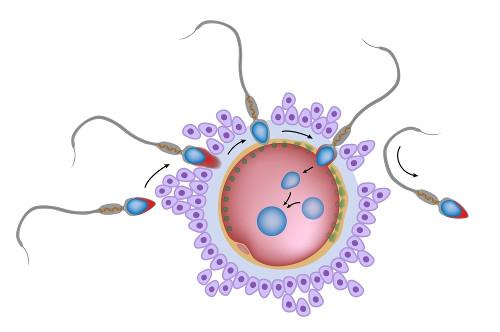Fertilization

Fertilization occurs when the sperm penetrates the egg and creates the first cell that can then become a new life. Although it seems a simple process, many factors must be timed correctly for this amazing event to happen!
The sperms' journey
Only 1 sperm is required to fertilize the egg, but many more will start the journey. There are millions of sperm deposited into the vagina during intercourse. These sperm will begin the journey towards the fallopian tube to meet the egg. Only about 100,000 will make it through the cervix into the uterus. During your fertile period your cervical mucus will aid the sperm on their journey. Many sperm will be lost on the journey through the uterus (they may go the wrong direction or may get trapped and die off) and ultimately only a few hundred will reach the egg. If no egg is present, the sperm can survive up to 5 days until ovulation occurs.
The egg's journey
The egg is released from the woman's ovary in a process called ovulation. Once released it is picked up by the fallopian tube and carried towards the uterus. The egg is only viable for 12-24 hours after release, if it meets healthy sperm during its journey in the fallopian tube, fertilization can occur.
Fertilization
Once the egg and the surviving sperm meet in the fallopian tube, the sperm will attempt to penetrate the surface of the egg. Only one sperm will successfully make it through and once it does, the surface of the egg will immediately change and become impenetrable ensuring that only one sperm can fertilize the egg.
The fertilized egg's journey
Once fertilized, the egg becomes a zygote, a single cell that will begin rapidly dividing. The sperm and the egg each contain half of the genetic material required to create a new life. The bundle of cells will continue the journey down the fallopian tube and into the uterus. Once it has divided into approximately 100 cells it becomes known as a blastocyst and will implant in the wall of the uterus. The journey from fertilization in the fallopian tube to implantation in the uterus usually takes 6 to 12 days. If the blastocyst does not travel to the uterus and instead implants in the fallopian tube (or elsewhere outside the womb) this is known as an ectopic pregnancy. Ectopic pregnancies are not viable, can be very dangerous for the mother, and require immediate treatment.


